| Acacia | |
|---|---|
 | |
| | |
| Scientific classification [ e ] | |
| Kingdom: | Plantae |
| clade: | Angiosperms |
| clade: | Eudicots |
| clade: | Rosids |
| Order: | Fabales |
| Family: | Fabaceae |
| Subfamily: | Mimosoideae |
| Tribe: | Acacieae |
| Genus: | Acacia Mill.[1] |
| Species | |
| About 1,300; see List of Acacia species | |
The generic name derives from ακακία (akakia), the name given by early Greek botanist-physician Pedanius Dioscorides (ca. 40-90) to the medicinal tree A. nilotica in his book Materia Medica.[2] This name derives from the Greek word for its characteristic thorns, ακις (akis, thorn).[3] The species name nilotica was given by Linnaeus from this tree's best-known range along the Nile river.
Acacias are also known as thorntrees, whistling thorns or wattles, including the yellow-fever acacia and umbrella acacias.
Until 2005, there were thought to be roughly 1300 species of acacia worldwide, about 960 of them native to Australia, with the remainder spread around the tropical to warm-temperate regions of both hemispheres, including Europe, Africa, southern Asia, and the Americas. However, the genus was then divided into five, with the name Acacia retained for the Australian species (and a few in tropical Asia, Madagascar and Pacific Islands), and most of the species outside Australia divided into Vachellia and Senegalia. The two final genera, Acaciella and Mariosousa, only contain about a dozen species from the Americas each.
Contents |
Classification
The genus Acacia is evidently not monophyletic. This discovery has led to the breaking up of Acacia into five new genera as discussed in: List of Acacia species. In common parlance, the term "acacia" is occasionally misapplied to species of the genus Robinia, which also belongs in the pea family. Robinia pseudoacacia, an American species locally known as Black Locust, is sometimes called "false acacia" in cultivation in the United Kingdom.Geography
The southernmost species in the genus are Acacia dealbata (Silver Wattle), Acacia longifolia (Coast Wattle or Sydney Golden Wattle), Acacia mearnsii (Black Wattle), and Acacia melanoxylon (Blackwood), reaching 43°30' S in Tasmania, Australia, while Acacia caven (Espinillo Negro) reaches nearly as far south in northeastern Chubut Province of Argentina. Australian species are usually called wattles, while African and American species tend to be known as acacias.Acacia albida, Acacia tortilis and Acacia iraqensis can be found growing wild in the Sinai desert and the Jordan valley. It is found in the savanna vegetation of the tropical continental climate. It grows wild in Montserrat West Indies; there it is locally referred to as 'cusha.'
Description
The leaves of acacias are compound pinnate in general. In some species, however, more especially in the Australian and Pacific islands species, the leaflets are suppressed, and the leaf-stalks (petioles) become vertically flattened, and serve the purpose of leaves. These are known as phyllodes. The vertical orientation of the phyllodes protects them from intense sunlight, as with their edges towards the sky and earth they do not intercept light so fully as horizontally placed leaves. A few species (such as Acacia glaucoptera) lack leaves or phyllodes altogether, but possess instead cladodes, modified leaf-like photosynthetic stems functioning as leaves.The small flowers have five very small petals, almost hidden by the long stamens, and are arranged in dense globular or cylindrical clusters; they are yellow or cream-colored in most species, whitish in some, even purple (Acacia purpureapetala) or red (Acacia leprosa Scarlet Blaze). Acacia flowers can be distinguished from those of a large related genus, Albizia, by their stamens which are not joined at the base. Also, unlike individual Mimosa flowers, those of Acacia have more than 10 stamens.[4]
The plants often bear spines, especially those species growing in arid regions. These sometimes represent branches which have become short, hard and pungent, or sometimes leaf-stipules. Acacia armata is the Kangaroo-thorn of Australia and Acacia erioloba is the Camelthorn of Africa.
Acacia seeds can be difficult to germinate. Research has found that immersing the seeds in various temperatures (usually around 80 °C) and manual seed coat chipping can improve yields to approximately 80 percent.[5]
Symbiosis
In the Central American Acacia sphaerocephala, Acacia cornigera, and Acacia collinsii (collectively known as the bullthorn acacias), the large thorn-like stipules are hollow and afford shelter for several species of Pseudomyrmex ants, which feed on a secretion of sap on the leaf-stalk and small, lipid-rich food-bodies at the tips of the leaflets called Beltian bodies. In return, the ants add protection to the plant against herbivores.[6] Some species of ants will also fight off competing plants around the acacia, cutting off the offending plant's leaves with their jaws and ultimately killing it. Other associated ant species appear to do nothing to benefit their hosts.Similar mutualisms with ants occur on Acacia trees in Africa, such as the Whistling Thorn acacia. The acacias provide shelter for ants in the thorns and nectar in extrafloral nectaries for their symbiotic ants such as Crematogaster mimosae. In turn, the ants protect the plant by attacking large mammalian herbivores and stem-boring beetles that damage the plant.
Pests
In Australia, Acacia species are sometimes used as food plants by the larvae of hepialid moths of the genus Aenetus including A. ligniveren. These burrow horizontally into the trunk then vertically down. Other Lepidoptera larvae which have been recorded feeding on Acacia include Brown-tail, Endoclita malabaricus and Turnip Moth. The leaf-mining larvae of some bucculatricid moths also feed on Acacia: Bucculatrix agilis feeds exclusively on Acacia horrida and Bucculatrix flexuosa feeds exclusively on Acacia nilotica.Acacias contain a number of organic compounds that defend them from pests and grazing animals.[7]
Uses
Food uses
Acacia seeds are often used for food and a variety of other products.In Burma, Laos and Thailand, the feathery shoots of Acacia pennata (common name cha-om, ชะอม and su pout ywet in Burmese) are used in soups, curries, omelettes, and stir-fries.
Honey made by bees using the acacia flower as forage is considered a delicacy, appreciated for its mild flowery taste, soft running texture and glass-like appearance. Acacia honey is one of the few honeys which does not crystallize.[8]
In Mexico the seeds are known as Guajes. Guajes or huajes are the flat, green pods of an acacia tree. The pods are sometimes light green or deep red in color—both taste the same. Guaje seeds are about the size of a small lima bean and are eaten raw with guacamole, sometimes cooked and made into a sauce. They can also be made into fritters. The ground seeds are used to impart a slightly garlicy flavor to a mole called guaxmole (huaxmole). The dried seeds may be toasted and salted and eaten as a snack referred to as "cacalas". Purchase whole long pods fresh or dried at Mexican specialty markets.
The first-known predominantly vegetarian spider Bagheera kiplingi, which is found in Central America and Mexico, was first documented and filmed in 2009 feeding from the tips of the acacia plants which are known as Beltian bodies which contain high concentrations of protein. All other 40,000 known species of spider's diets are mainly believed to be carnivorous.
Acacia is listed as an ingredient in Sun Drop, Fresca, a citrus soft drink, RC Cola, Barq's root beer, Full Throttle Unleaded Energy Drink, Strawberry-Lemonade Powerade[9] as well as in Läkerol pastille candies, Altoids mints, Langer's Pineapple coconut Juice, Wrigley's Eclipse chewing gum and M&Ms Pretzel.
Gum
Various species of acacia yield gum. True gum arabic is the product of Acacia senegal, abundant in dry tropical West Africa from Senegal to northern Nigeria.Acacia arabica is the gum-Arabic tree of India, but yields a gum inferior to the true gum-Arabic.
Medicinal uses
Many Acacia species have important uses in traditional medicine. Most of the uses have been shown to have a scientific basis since chemical compounds found in the various species have medicinal effects.[citation needed]In Ayurvedic medicine, Acacia nilotica is considered a remedy that is helpful for treating premature ejaculation. A 19th century Ethiopian medical text describes a potion made from an Ethiopian species of Acacia (known as grar) mixed with the root of the tacha, then boiled, as a cure for rabies.[10]
An astringent medicine high in tannins, called catechu or cutch, is procured from several species, but more especially from Acacia catechu, by boiling down the wood and evaporating the solution so as to get an extract.[11]
Ornamental uses
A few species are widely grown as ornamentals in gardens; the most popular perhaps is Acacia dealbata (Silver Wattle), with its attractive glaucous to silvery leaves and bright yellow flowers; it is erroneously known as "mimosa" in some areas where it is cultivated, through confusion with the related genus Mimosa.Another ornamental acacia is Acacia xanthophloea (Fever Tree). Southern European florists use Acacia baileyana, Acacia dealbata, Acacia pycnantha and Acacia retinodes as cut flowers and the common name there for them is mimosa.[12]
Ornamental species of acacia are also used by homeowners and landscape architects for home security. The sharp thorns of some species deter unauthorized persons from entering private properties, and may prevent break-ins if planted under windows and near drainpipes. The aesthetic characteristics of acacia plants, in conjunction with their home security qualities, makes them a considerable alternative to artificial fences and walls.
Paints
The ancient Egyptians used Acacia in paints.[13]Perfume
Acacia farnesiana is used in the perfume industry due to its strong fragrance. The use of Acacia as a fragrance dates back centuries. In the Bible, burning of acacia wood as a form of incense is mentioned several times.Symbolism and ritual
The Acacia is used as a symbol in Freemasonry, to represent purity and endurance of the soul, and as funerary symbolism signifying resurrection and immortality. The tree gains its importance from the description of the burial of Hiram Abiff, the builder of King Solomon's Temple in Jerusalem.Several parts (mainly bark, root and resin) of Acacia are used to make incense for rituals. Acacia is used in incense mainly in India, Nepal, and China including in its Tibet region. Smoke from Acacia bark is thought to keep demons and ghosts away and to put the gods in a good mood. Roots and resin from Acacia are combined with rhododendron, acorus, cytisus, salvia and some other components of incense. Both people and elephants like an alcoholic beverage made from acacia fruit.[14] According to Easton's Bible Dictionary, the Acacia tree may be the “burning bush” (Exodus 3:2) which Moses encountered in the desert.[15] Also, when God gave Moses the instructions for building the Tabernacle, he said to "make an ark of acacia wood" and "make a table of acacia wood" (Exodus 25:10 & 23, Revised Standard Version)
In Russia, Italy and other countries it is customary to present women with yellow mimosas (among other flowers) on International Women's Day (March 8). These "mimosas" are actually from Acacia dealbata (Silver Wattle).
Tannin
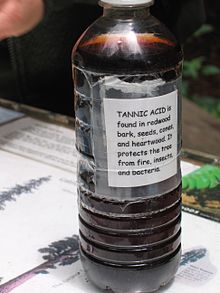
A bottle of tannic acid.
| | | | |
| Species | | | |
| Acacia albida | | | |
| Acacia cavenia | 32%[17] | ||
| Acacia dealbata | 19.1%[18] | ||
| Acacia decurrens | 37-40%[18] | ||
| Acacia farnesiana | 23%[18] | ||
| Acacia mearnsii | 25-35%[16] | ||
| Acacia melanoxylon | 20%[17] | ||
| Acacia nilotica | 18-23%*[16] | ||
| Acacia penninervis | 18%[17] | ||
| Acacia pycnantha | 30-45%[17] | 15-16%[17] | |
| Acacia saligna | 21.5%[18] | ||
| Notes: * - Inner bark | |||
Wood

| | | | |
| Species | | | |
| Acacia acuminata | | ||
| Acacia amythethophylla | | ||
| Acacia catechu | | ||
| Acacia confusa | | ||
| Acacia erioloba | | ||
| Acacia galpinii | | ||
| Acacia goetzii | | ||
| Acacia karoo | | ||
| Acacia leucophloea | | ||
| Acacia melanoxylon | | ||
| Acacia mellifera subsp. mellifera | | ||
| Acacia nilotica | | | |
| Acacia nilotica subsp. adstringens | | ||
| Acacia nilotica subsp. nilotica | | | |
| Acacia polyacantha subsp. campylacantha | | ||
| Acacia sieberiana | |
In Indonesia (mainly in Sumatra) and in Malaysia (mainly in Sarawak) plantations of Acacia mangium are being established to supply pulpwood to the paper industry.
Land Reclamation
Acacia can be planted for erosion control, especially after mining or construction damage.[24]Ecological invasion
For the same reasons it is favored as an erosion-control plant, with its easy spreading and resilience, some varieties of acacia, namely Acacia mearnsii, are potentially an invasive species. Introduced worldwide it has become an invasive plant which is taking over grasslands and the abandoned agricultural areas, especially in moderate coastal and island regions where mild climate propagates its spreading. Australian/New Zealand Weed Risk Assessment gives it a "high risk, score of 15" rating and it is considered one of the world's 100 most invasive species.[25] Extensive ecological studies should be performed before further introduction of acacia varieties as this fast-growing plant, once introduced, spreads fast and is extremely difficult to eradicate.Phytochemistry of Acacia
Alkaloids
As mentioned previously, Acacias contain a number of organic compounds that defend them from pests and grazing animals.[7] Many of these compounds are psychoactive in humans. The alkaloids found in Acacias include dimethyltryptamine (DMT), 5-methoxy-dimethyltryptamine (5-MeO-DMT) and N-methyltryptamine (NMT). The plant leaves, stems and/or roots are sometimes made into a brew together with some MAOI-containing plant and consumed orally for healing, ceremonial or religious uses. Egyptian mythology has associated the acacia tree with characteristics of the tree of life (see the article on the Myth of Osiris and Isis).| | Up to 1.5% alkaloids, mainly consisting of tryptamine in leaf[26] |
| | β-methyl-phenethylamine, 2.4% in leaves[27] |
 | Active principles in leaf[28] |
 | Ash used in Pituri.[29] Ether extracts about 2-6% of the dried leaf mass.[30] Not known if psychoactive per se. |
 | β-methyl-phenethylamine,[31] NMT and DMT in leaf (1.1-10.2 ppm)[32] |
 | Tryptamine alkaloids.[33] Significant amount of tryptamine in the seeds.[34] |
 | 5-MeO-DMT in stem bark[35] |
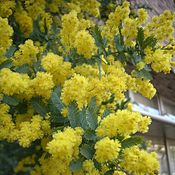 | 0.02% tryptamine and β-carbolines, in the leaf, Tetrahydroharman[28][36][37] |
| | Psychoactive[38] Ash used in Pituri.[29] |
 | DMT, amphetamines, mescaline, nicotine[39] |
 | DMT[40] and other tryptamines in leaf, bark |
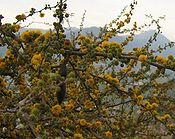 | Tryptamines |
 | DMT and other tryptamines in leaf, bark |
| | DMT[41] |
| | 0.3% alkaloids in leaf and stem, almost all N-methyl-tetrahydroharman, with traces of tetrahydroharman, some of tryptamine[42][43][44] |
 | Nicotine[45] |
 | DMT & NMT in leaf, stem & bark 0.04% NMT and 0.02% DMT in stem.[28] Also N,N-dimethyltryptamine N-oxide[46] |
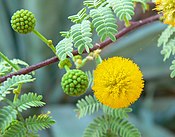 | β-methyl-phenethylamine[31] |
| | Ash used in Pituri.[29][47] Not known if psychoactive. |
 | Psychoactive,[47] Tryptamines[14] |
 | Tryptamine, in the leaf, stem[28] and seeds.[34] Phenethylamine in leaf and seeds[34] |
| | Psychoactive[38] |
| | Psychoactive[38] |
 | Psychoactive,[38] but less than 0.02% alkaloids[37] |
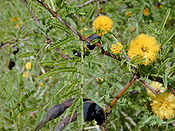 | Traces of 5-MeO-DMT[48] in fruit. β-methyl-phenethylamine, flower.[49] Ether extracts about 2-6% of the dried leaf mass.[30] Alkaloids are present in the bark[50] and leaves.[51] Amphetamines and mescaline also found in tree.[14] |
| | Added to Pulque, but not known if psychoactive[47] |
| | Tryptamine, phenethylamine,[52] in flowers[34] other tryptamines, phenethylamines[53] |
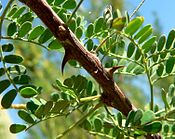 | N-methyl-β-phenethylamine,[31] phenethylamine[7] |
| | Phenethylamine, hordenine at a ratio of 2:3 in dried leaves, 0.6% total[27] |
| | Hordenine, 1.2% in bark[27] |
 | Psychoactive[47] |
 | Psychoactive[54] |
| | DMT, NMT |
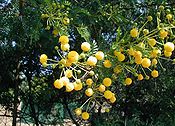 | Psychoactive |
| | Used in Pituri, but not known if psychoactive.[47] |
| | 1.5[27]-1.88%[55] alkaloids, 92% consisting of phenylethylamine.[27] 0.9% N-methyl-2- phenylethylamine found a different time.[27] |
| | DMT, in the leaf[28] |
| | Used in Pituri, but not known if psychoactive.[47] |
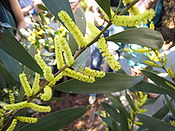 | 0.2% tryptamine in bark, leaves, some in flowers, phenylethylamine in flowers,[52] 0.2% DMT in plant.[56] Histamine alkaloids.[37] |
| | Tryptamine in leaves, bark[34] |
| | Tryptamine[34] |
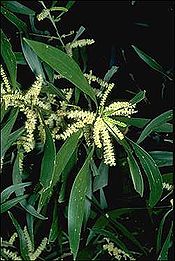 | 0.6% NMT and DMT in about a 2:3 ratio in the stem bark, both present in leaves[28] |
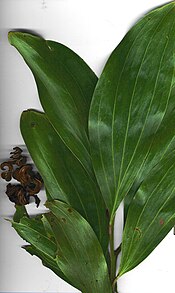 | Psychoactive[47] |
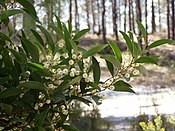 | DMT, in the bark and leaf,[57] but less than 0.02% total alkaloids[37] |
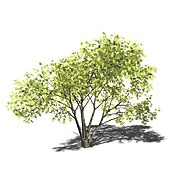 | DMT, in the leaf[28] |
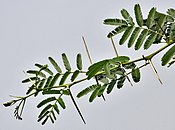 | DMT, in the leaf[28] |
| | Psychoactive, DMT in the leaf |
| | Tryptamine, DMT, NMT, other tryptamines,[58] 0.4-0.5% in dried bark, 0.07% in branch tips.[59] |
| | Less than 0.1% DMT in leaf,[36][60] NMT |
| | Psychoactive[38] |
 | 0.3% DMT in leaf, NMT[28] |
 | Tryptamine in the leaf,[28] 0.5% to 2% DMT in fresh bark, phenethylamine, trace amounts[52] |
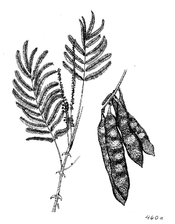 | DMT in leaf[28] and other tryptamines in leaf, bark |
| | Less than 0.2% DMT in leaf, NMT; DMT and other tryptamines in leaf, bark[61] |
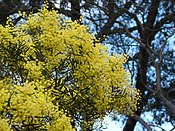 | Phenylethylamine, β-methyl-phenethylamine[27][52] |
| | Ash used in Pituri.[29][47] Not known if psychoactive. |
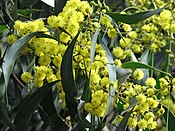 | Ash used in Pituri,[47] but less than 0.02% total alkaloids.[37] Not known if psychoactive. |
 | DMT, NMT,[62] nicotine,[14] but less than 0.02% total alkaloids found[37] |
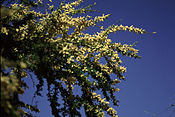 | DMT, NMT, tryptamine, amphetamines, mescaline, nicotine and others[63] |
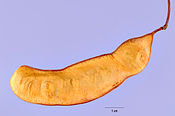 | β-methyl-phenethylamine[31] |
 | Acacia rose blooming in the garden.[28] |
 | Ash used in Pituri.[29][47] Not known if psychoactive. |
 | Psychoactive[47] |
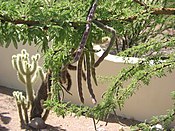 | β-methyl-phenethylamine, Phenethylamine[7] Amphetamines and mescaline also found.[14] |
| | β-methyl-phenethylamine[31] |
 | Less than 0.1% DMT in leaf,[28] NMT, other tryptamines. DMT in plant,[49] DMT in bark.[34] |
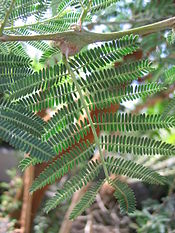 | DMT, in the leaf.[28] Ether extracts about 1-7% of the dried leaf mass.[30] |
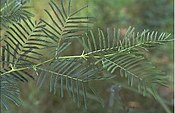 | DMT, in the leaf[28] |
 | DMT and NMT, in the leaf, stem and trunk bark, 0.81% DMT in bark, MMT[28][64] |
| | β-methyl-phenethylamine[31] |
 | DMT, NMT, and other tryptamines[58] |
| | Tryptamine, in the leaf and stem,[28] but less than 0.02% total alkaloids[37] |
| | Tryptamines, 5-MeO-alkyltryptamine[34] |
[edit] List of acacia species having little or no alkaloids in the material sampled:[37]
0% C
C  0.02%, C...Concentration of Alkaloids [%]
0.02%, C...Concentration of Alkaloids [%]- Acacia acinacea
- Acacia baileyana
- Acacia decurrens
- Acacia dealbata
- Acacia mearnsii
- Acacia drummondii
- Acacia elata
- Acacia falcata
- Acacia leprosa
- Acacia linearis
- Acacia melanoxylon
- Acacia pycnantha
- Acacia retinodes
- Acacia saligna
- Acacia stricta
- Acacia verticillata
- Acacia vestita
Cyanogenic glycosides
Nineteen different species of Acacia in the Americas contain cyanogenic glycosides, which, if exposed to an enzyme which specifically splits glycosides, can release hydrogen cyanide (HCN) in the acacia "leaves."[65] This sometimes results in the poisoning death of livestock.If fresh plant material spontaneously produces 200 ppm or more HCN, then it is potentially toxic. This corresponds to about 7.5 μmol HCN per gram of fresh plant material. It turns out that, if acacia "leaves" lack the specific glycoside-splitting enzyme, then they may be less toxic than otherwise, even those containing significant quantities of cyanic glycosides.[37]
Some Acacia species containing cyanogens:
- Acacia erioloba
- Acacia cunninghamii
- Acacia obtusifolia
- Acacia sieberiana
- Acacia sieberiana var. woodii[66]
Species
There are over 1,300 species of Acacia. See List of Acacia species for a more complete listing.Famous acacia
Perhaps the most famous acacia is the Arbre du Ténéré in Niger. The reason for the tree's fame is that it used to be the most isolated tree in the world, approximately 400 km (249 mi) from any other tree. The tree was knocked down by a truck driver in 1973.Identification gallery
Flowers
| | |||
| | | |
Bark
| | | | |
| | |||
| | | | |
Foliage
| | | | |
| | | |
Seed pods
Seeds
Thorns
| |

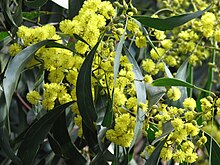




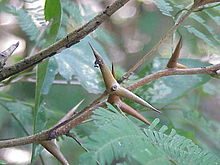
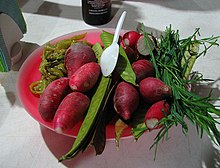
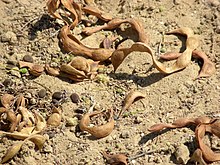
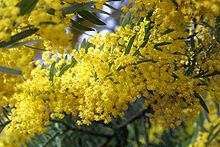


































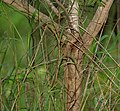










































No comments:
Post a Comment